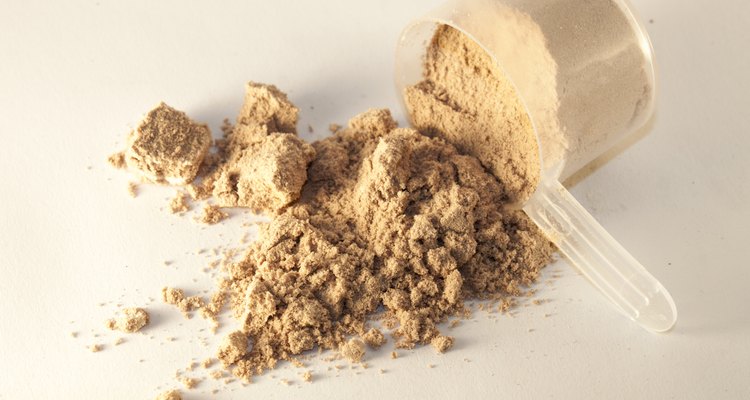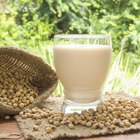
Saaster/iStock/Getty Images
Boost the nutrition of your favorite baked goods, smoothies, shakes or main dishes by stirring in wheat germ or powdered whey. Wheat germ comes from the inner germ of wheat kernels, while whey is the liquid left over after preparing dairy products such as yogurt or cheese. Both are dense with nutrients, though they differ in the types they offer.
Whey's Lower in Fat
A 2-tablespoon serving of sweet dried whey, the most common whey powder variety, contains 53 calories. Just 1.4 of these calories come from whey's 0.16 gram total of saturated, polyunsaturated and monounsaturated fats. Wheat germ contains 61 calories in every 2-tablespoon serving, with 1.6 grams of total fat. That's more fat than whey, but most of wheat germ's fat -- approximately 1 gram -- is heart-healthy polyunsaturated fat.
"Whey" Better for Protein
Wheat germ contains about 5.3 grams of protein per 2-tablespoon serving; whey supplies just under 2 grams. The difference is that whey's protein is complete: It contains all the amino acids your body needs to make cellular tissue and protein-based compounds such as enzymes. Wheat germ, like most plant foods, lacks some of these essential amino acids, making it an incomplete protein source.
Choose Wheat Germ for Fiber
Whey supplies 11 grams of carbohydrates in every 2 tablespoons. All of these carbs are lactose, the simple sugar predominant in dairy products. With 8.3 grams per serving, wheat germ has fewer carbohydrates, but nearly 25 percent is dietary fiber. This amount fulfills 7 percent of the recommended daily intake for women 19 to 30 years old and almost 6 percent of the requirement for men the same age.
Boost Your Micronutrients
Wheat germ comes packed with vitamins and minerals. Add 2 tablespoons of wheat germ to your morning smoothie, and you'll get 20 percent of the thiamine, folate, phosphorus and zinc you need for the day, and over 100 percent of your manganese. Whey powder also supplies B vitamins and phosphorus, but in smaller concentrations. It is, however, a better source of calcium, with 119 milligrams per 2 tablespoons, almost 12 percent of an adult's daily requirement.
Related Articles

Facts About Yoplait Yogurt

How to Make Fresh Strawberry Frosting ...

How to Use Shower Gel

How to Use Essential Oils Instead of ...

The Carbohydrates in Blueberries

Soy Milk Powder Vs. Liquid

Calories in a Tablespoon of Cream Cheese

How to Make Glaze for Donuts With Milk ...
How to Mix Baking Soda & Peroxide

Calories in Cheese Cubes

Substitute for Curd

Whole vs. Low-Fat Buttermilk

How to Make Yogurt Shampoo

How to Dissolve Non-Instant Milk Powder

How to Make Natural Deodorant From ...

How to Fix Curdled Whipped Cream

How to Make a Lip Mask for Extremely ...

How to Make a Seaweed Body Wrap

How to Get Your Mustache to Connect in ...

Will Cream of Tartar Whiten Teeth?
References
Writer Bio
Michelle Kerns writes for a variety of print and online publications and specializes in literature and science topics. She has served as a book columnist since 2008 and is a member of the National Book Critics Circle. Kerns studied English literature and neurology at UC Davis.
Photo Credits
Saaster/iStock/Getty Images